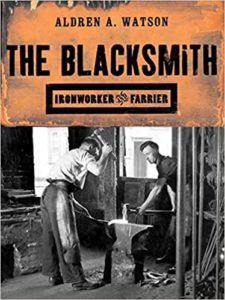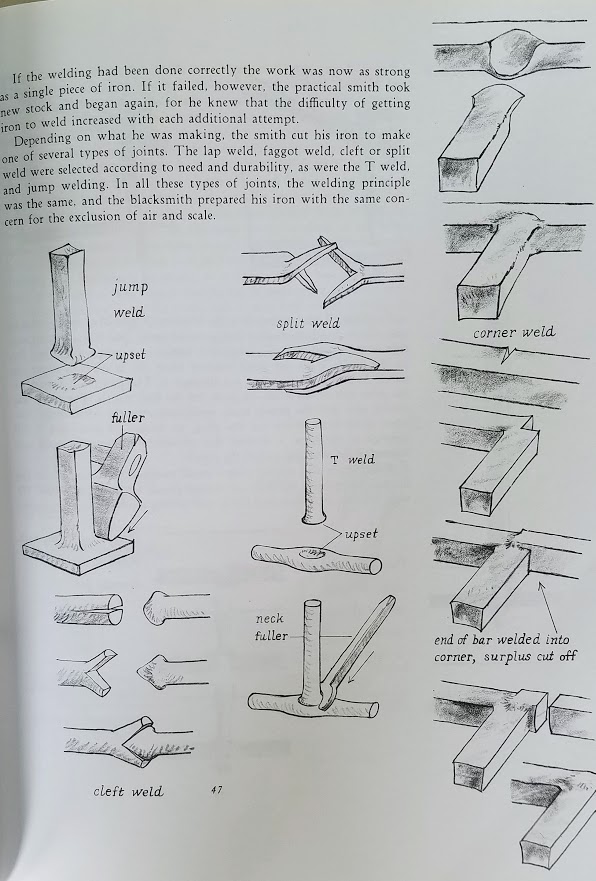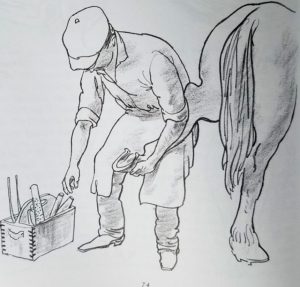By: Aldren A. Watson – Published 1977
Original Title: The Village Blacksmith

Price : $ – Amazon
Philip’s Ranking: 3
Beginner Blacksmith: 2
Advanced Blacksmith: 1
Inspiration: 2
Historical: 3
Video Review: N/A
The Blacksmith: Ironworker And Farrier by Aldren A. Watson is one of several books Watson published. His other books include Furniture Making Plain & Simple, Hand Tools: Their Ways and Workings, Country Furniture, Hand Bookbinding: A Manual of Instruction, and The Watson Drawing Book.
Published in 1977 Watson was writing as blacksmithing was beginning to see a resurgence of interest and a new generation of blacksmiths rediscovering a craft that had largely died out in the early 1900s. A professional artist, author, book lillustrator, printmaker, hand bookbinder, and master woodworker Watson had his childhood in an age where cars were starting to replace horse carts and the classic village blacksmith was being replaced by mass produced factory items.
The Blacksmith: Ironworker & Farrier published when Watson was nearing 60 is a treatise on a lost way of life and the childhood it represents as much as it is a book about blacksmithing. The entire work has an air of nostalgia for cold winters, small towns, hard work, and simple lives. It paints a lovely and endearing image but the world of our childhoods often seems simpler and more pleasant than it actually was. A blacksmith in his forge chatting with a farmer as he shoes a horse while his young apprentice pulls at the bellows is a lovely image but I’d guess any of those smiths would be happy to trade the bellows for an electric blower and a power hammer.

As a professional artist the illustrations are stunning through the book and many of the techniques are better understood looking at the drawings rather than reading the accompanying text. A good example is the two pages on different types of forge welds (see one page to the right) where they drawings can quickly explain processes that would be a challenge written out.
Contents:
- Prologue – pg 1
- In the Beginning – pg 7
- Wrought Iron: Its Properties and Manufacture – pg 13
- The Blacksmith Shop and Forge Fire – pg 23
- Working at the Forge – pg 33
- Hardware and Harness – pg 53
- Shoeing a Horse – pg 69
- Wagons, Buggies, and Sleds – pg 81
- The Blacksmith in His World – pg 93
- Building a Forge – pg 101
- Building a Leather Lung Bellows – pg 129
- Epilogue – pg 147
- Appendix – pg 153
Looking at the contents of the book we get a pretty good idea of how the book is divided up.
I’d bucket the chapters into a few major areas:
- Nostalgia / History – 46 pages
- In the Beginning
- Wrought Iron: Its Properties and Manufacture
- The Blacksmith in His World
- Epilogue
- Appendix
- Intro to blacksmithing – 20 pages
- The Blacksmith Shop and Forge Fire
- Working at the Forge
- Horses and their equipment – 23 pages
- Hardware and Harness
- Shoeing a Horse
- Wagons, Buggies, and Sleds
- Building a brick forge and bellows – 45 pages
- Building a Forge
- Building a Leather Lung Bellows
 As you can see from just the space dedicated to the book this book is going to best for someone who wants to build an 1800s reproduction blacksmith shop as almostthe entire book is dedicated that theme. If you are a reenactor reading this book will give you the info you need to carry on conversations about the sort of work the blacksmith did and how they did it.
As you can see from just the space dedicated to the book this book is going to best for someone who wants to build an 1800s reproduction blacksmith shop as almostthe entire book is dedicated that theme. If you are a reenactor reading this book will give you the info you need to carry on conversations about the sort of work the blacksmith did and how they did it.
If you are a beginner blacksmith I don’t think this book is going to really get you going unless your plan is to start by laying out a few thousand dollars building a reproduction blacksmith shop. That being said the book is worth picking up for the history and the wonderful drawings.